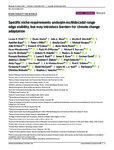Specific niche requirements underpin multidecadal range edge stability, but may introduce barriers for climate change adaptation
| dc.contributor.author | Firth, Louise | |
| dc.contributor.author | Harris, D | |
| dc.contributor.author | Blaze, Julie | |
| dc.contributor.author | Marzloff, Martin | |
| dc.contributor.author | Boyé, Aurélien | |
| dc.contributor.author | Miller, Peter | |
| dc.contributor.author | Curd, Amelia | |
| dc.contributor.author | Vasquez, Mickael | |
| dc.contributor.author | Nunn, JD | |
| dc.contributor.author | O'Connor, Nessa | |
| dc.contributor.author | Power, Anne Marie | |
| dc.contributor.author | Mieszkowska, Nova | |
| dc.contributor.author | O’Riordan, RM | |
| dc.contributor.author | Burrows, Michael | |
| dc.contributor.author | Bricheno, Lucy | |
| dc.contributor.author | Knights, Antony | |
| dc.contributor.author | Nunes, Flavia | |
| dc.contributor.author | Bordeyne, François | |
| dc.contributor.author | Bush, LE | |
| dc.contributor.author | Byers, James | |
| dc.contributor.author | David, Carmen L | |
| dc.contributor.author | Davies, Andrew | |
| dc.contributor.author | Dubois, Stanislas | |
| dc.contributor.author | Edwards, Hugh | |
| dc.contributor.author | Foggo, Andrew | |
| dc.contributor.author | Grant, L | |
| dc.contributor.author | Green, JAM | |
| dc.contributor.author | Gribben, Paul | |
| dc.contributor.author | Lima, Fernando | |
| dc.contributor.author | McGrath, D | |
| dc.contributor.author | Noël, LMLJ | |
| dc.contributor.author | Seabra, Rui | |
| dc.contributor.author | Simkanin, Christina | |
| dc.contributor.author | Hawkins, Stephen | |
| dc.date.accessioned | 2021-02-08T14:40:04Z | |
| dc.date.available | 2021-02-08T14:40:04Z | |
| dc.date.issued | 2021-04 | |
| dc.identifier.issn | 1366-9516 | |
| dc.identifier.issn | 1472-4642 | |
| dc.identifier.uri | http://hdl.handle.net/10026.1/16862 | |
| dc.description.abstract |
<jats:title>Abstract</jats:title><jats:sec><jats:title>Aim</jats:title><jats:p>To investigate some of the environmental variables underpinning the past and present distribution of an ecosystem engineer near its poleward range edge.</jats:p></jats:sec><jats:sec><jats:title>Location</jats:title><jats:p>>500 locations spanning >7,400 km around Ireland.</jats:p></jats:sec><jats:sec><jats:title>Methods</jats:title><jats:p>We collated past and present distribution records on a known climate change indicator, the reef‐forming worm <jats:italic>Sabellaria alveolata</jats:italic> (Linnaeus, 1767) in a biogeographic boundary region over 182 years (1836–2018). This included repeat sampling of 60 locations in the cooler 1950s and again in the warmer 2000s and 2010s. Using species distribution modelling, we identified some of the environmental drivers that likely underpin <jats:italic>S. alveolata</jats:italic> distribution towards the leading edge of its biogeographical range in Ireland.</jats:p></jats:sec><jats:sec><jats:title>Results</jats:title><jats:p>Through plotting 981 records of presence and absence, we revealed a discontinuous distribution with discretely bounded sub‐populations, and edges that coincide with the locations of tidal fronts. Repeat surveys of 60 locations across three time periods showed evidence of population increases, declines, local extirpation and recolonization events within the range, but no evidence of extensions beyond the previously identified distribution limits, despite decades of warming. At a regional scale, populations were relatively stable through time, but local populations in the cold Irish Sea appear highly dynamic and vulnerable to local extirpation risk. Contemporary distribution data (2013–2018) computed with modelled environmental data identified specific niche requirements which can explain the many distribution gaps, namely wave height, tidal amplitude, stratification index, then substrate type.</jats:p></jats:sec><jats:sec><jats:title>Main conclusions</jats:title><jats:p>In the face of climate warming, such specific niche requirements can create environmental barriers that may prevent species from extending beyond their leading edges. These boundaries may limit a species’ capacity to redistribute in response to global environmental change.</jats:p></jats:sec> | |
| dc.format.extent | 668-683 | |
| dc.language | en | |
| dc.language.iso | en | |
| dc.publisher | Wiley | |
| dc.subject | biogenic habitat | |
| dc.subject | biogeography | |
| dc.subject | cold event | |
| dc.subject | Irish Sea | |
| dc.subject | macroecology | |
| dc.subject | tidal front | |
| dc.title | Specific niche requirements underpin multidecadal range edge stability, but may introduce barriers for climate change adaptation | |
| dc.type | journal-article | |
| dc.type | Journal Article | |
| plymouth.author-url | https://www.webofscience.com/api/gateway?GWVersion=2&SrcApp=PARTNER_APP&SrcAuth=LinksAMR&KeyUT=WOS:000613703200001&DestLinkType=FullRecord&DestApp=ALL_WOS&UsrCustomerID=11bb513d99f797142bcfeffcc58ea008 | |
| plymouth.issue | 4 | |
| plymouth.volume | 27 | |
| plymouth.publication-status | Published | |
| plymouth.journal | Diversity and Distributions | |
| dc.identifier.doi | 10.1111/ddi.13224 | |
| plymouth.organisational-group | /Plymouth | |
| plymouth.organisational-group | /Plymouth/Faculty of Science and Engineering | |
| plymouth.organisational-group | /Plymouth/Faculty of Science and Engineering/School of Biological and Marine Sciences | |
| plymouth.organisational-group | /Plymouth/REF 2021 Researchers by UoA | |
| plymouth.organisational-group | /Plymouth/REF 2021 Researchers by UoA/UoA07 Earth Systems and Environmental Sciences | |
| plymouth.organisational-group | /Plymouth/Research Groups | |
| plymouth.organisational-group | /Plymouth/Research Groups/Marine Institute | |
| plymouth.organisational-group | /Plymouth/Users by role | |
| plymouth.organisational-group | /Plymouth/Users by role/Academics | |
| plymouth.organisational-group | /Plymouth/Users by role/Researchers in ResearchFish submission | |
| dc.identifier.eissn | 1472-4642 | |
| dc.rights.embargoperiod | Not known | |
| rioxxterms.versionofrecord | 10.1111/ddi.13224 | |
| rioxxterms.licenseref.uri | http://www.rioxx.net/licenses/all-rights-reserved | |
| rioxxterms.type | Journal Article/Review |


